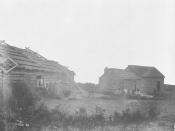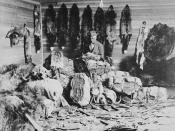Metis People and the Fur Trade
European Fur Trade:
Three factors led to the development of large-scale fur trading within the Metis communities of the North. The first was the bountiful supply of furs in North America. The Canadian Shield and the Mackenzie Delta were the greatest fur areas in the world as its environment was an ideal habitat for many fur-bearing animals. Cold winters meant that the animals had a thick rich coat through most of the year.
The second factor was the growing demand for furs in Europe. Initially, furs were wanted for the manufacture of garments, either as a basic material or as trim. The felt hat, however, eventually became the focus of the fur demand. For these hats, only the soft, downy under hair or wool of the fur was used. This wool was first separated from the skin and the long; smooth guard hairs (Fur Trapping, Jaws on Paws.
Coalition to abolish the fur trade.). It was then used as a raw material for making felt hats. Fur used in this way was called staple fur. Only certain furs were suitable for use as staple fur: rabbit, muskrat, and above all beaver. On these animals, the wool fibers have microscopic barbs, which interlock with one another when the wool is made into felt. This results in a very strong, wear-resistant product. Because the beaver fur was generally used on the surface of the hat, the hats became known as "beaver hats". The beaver hat industry was of central importance to the fur trade. By the 1700's, staple fur accounted for 60% of English fur import. The beaver became the emblem of the Hudson's Bay Company and its standard value for trade. Other furs and trade goods were evaluated in terms of the beaver (HBC Archives).


